Why Is Red Marrow Only Found in Babies Why Is Red Marrkw in Babies
| Bone marrow | |
|---|---|
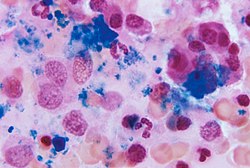 A section of bone marrow tissue | |
| Details | |
| Organisation | Hematopoietic system Immune system[1] Lymphatic system |
| Identifiers | |
| Latin | Medulla ossium |
| MeSH | D001853 |
| TA98 | A13.one.01.001 |
| TA2 | 388 |
| FMA | 9608 |
| Anatomical terminology [edit on Wikidata] | |
Bone marrow is a semi-solid tissue found within the spongy (also known as cancellous) portions of bones.[2] In birds and mammals, os marrow is the primary site of new blood cell product (or haematopoiesis).[iii] It is composed of hematopoietic cells, marrow adipose tissue, and supportive stromal cells. In adult humans, bone marrow is primarily located in the ribs, vertebrae, sternum, and basic of the pelvis.[4] Bone marrow comprises approximately five% of total body mass in healthy adult humans, such that a human weighing 73 kg (161 lbs) will take around 3.7 kg (8 lbs) of os marrow.[v]
Human marrow produces approximately 500 billion blood cells per 24-hour interval, which join the systemic circulation via permeable vasculature sinusoids within the medullary cavity.[6] All types of hematopoietic cells, including both myeloid and lymphoid lineages, are created in bone marrow; all the same, lymphoid cells must drift to other lymphoid organs (eastward.g. thymus) in gild to complete maturation.
Bone marrow transplants can exist conducted to care for severe diseases of the bone marrow, including certain forms of cancer such as leukemia. Several types of stem cells are related to os marrow. Hematopoietic stem cells in the bone marrow tin can give rise to hematopoietic lineage cells, and mesenchymal stalk cells, which tin can be isolated from the main culture of bone marrow stroma, can give rise to bone, adipose, and cartilage tissue.[seven]
Structure [edit]
The composition of marrow is dynamic, equally the mixture of cellular and non-cellular components (connective tissue) shifts with age and in response to systemic factors. In humans, marrow is colloquially characterized as "red" or "yellow" marrow (Latin: medulla ossium rubra, Latin: medulla ossium flava, respectively) depending on the prevalence of hematopoietic cells vs fat cells. While the precise mechanisms underlying marrow regulation are non understood,[half-dozen] compositional changes occur co-ordinate to stereotypical patterns.[eight] For case, a newborn baby's bones exclusively comprise hematopoietically active "red" marrow, and at that place is a progressive conversion towards "yellow" marrow with historic period. In adults, red marrow is found mainly in the central skeleton, such as the pelvis, sternum, cranium, ribs, vertebrae and scapulae, and variably constitute in the proximal epiphyseal ends of long bones such equally the femur and humerus. In circumstances of chronic hypoxia, the body can catechumen xanthous marrow back to cerise marrow to increase blood cell production.[9]
Hematopoietic components [edit]
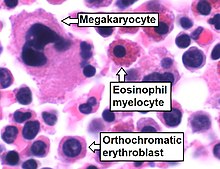
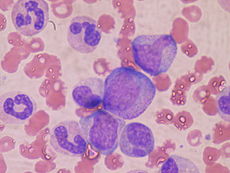
At the cellular level, the chief functional component of bone marrow includes the progenitor cells which are destined to mature into blood and lymphoid cells. Human being marrow produces approximately 500 billion blood cells per day.[10] Marrow contains hematopoietic stem cells which give rising to the three classes of blood cells that are found in circulation: white claret cells (leukocytes), ruddy blood cells (erythrocytes), and platelets (thrombocytes).[11]
| Group | Jail cell type | Boilerplate fraction | Reference range |
|---|---|---|---|
| Myelopoietic cells | Myeloblasts | 0.nine | 0.2–1.5 |
| Promyelocytes | iii.three% | 2.ane–4.1 | |
| Neutrophilic myelocytes | 12.7% | 8.2–fifteen.7 | |
| Eosinophilic myelocytes | 0.8% | 0.2–1.3 | |
| Neutrophilic metamyelocytes | fifteen.9% | 9.6–24.6 | |
| Eosinophilic metamyelocytes | 1.2% | 0.4–2.2 | |
| Neutrophilic band cells | 12.four% | nine.5–fifteen.3 | |
| Eosinophilic ring cells | 0.9% | 0.2–two.4 | |
| Segmented neutrophils | 7.4% | half dozen.0–12.0 | |
| Segmented eosinophils | 0.5% | 0.0–ane.three | |
| Segmented basophils and mast cells | 0.1% | 0.0–0.2 | |
| Erythropoietic cells | Pronormoblasts | 0.6% | 0.2–1.3 |
| Basophilic normoblasts | ane.4% | 0.v–2.4 | |
| Polychromatic normoblasts | 21.6% | 17.nine–29.2 | |
| Orthochromatic normoblast | 2.0% | 0.4–4.half dozen | |
| Other cell types | Megakaryocytes | < 0.1% | 0.0-0.4 |
| Plasma cells | 1.three% | 0.iv-iii.9 | |
| Reticular cells | 0.3% | 0.0-0.9 | |
| Lymphocytes | xvi.2% | 11.one-23.2 | |
| Monocytes | 0.three% | 0.0-0.8 |
Stroma [edit]
The stroma of the bone marrow includes all tissue not straight involved in the marrow'south primary office of hematopoiesis.[vi] Stromal cells may be indirectly involved in hematopoiesis, providing a microenvironment that influences the part and differentiation of hematopoietic cells. For instance, they generate colony stimulating factors, which have a meaning effect on hematopoiesis. Prison cell types that constitute the bone marrow stroma include:
- fibroblasts (reticular connective tissue)
- macrophages, which contribute especially to cherry blood prison cell production, as they deliver iron for hemoglobin product.
- adipocytes (fat cells)
- osteoblasts (synthesize os)
- osteoclasts (resorb os)
- endothelial cells, which form the sinusoids. These derive from endothelial stem cells, which are also nowadays in the bone marrow.[11]
Part [edit]
Mesenchymal stem cells [edit]
The bone marrow stroma contains mesenchymal stem cells (MSCs),[11] which are too known equally marrow stromal cells. These are multipotent stalk cells that can differentiate into a variety of prison cell types. MSCs have been shown to differentiate, in vitro or in vivo, into osteoblasts, chondrocytes, myocytes, marrow adipocytes and beta-pancreatic islets cells.[ citation needed ]
Os marrow barrier [edit]
The blood vessels of the bone marrow plant a barrier, inhibiting immature blood cells from leaving the marrow. But mature blood cells incorporate the membrane proteins, such as aquaporin and glycophorin, that are required to attach to and pass the blood vessel endothelium.[13] Hematopoietic stem cells may too cross the bone marrow barrier, and may thus be harvested from blood.[ citation needed ]
Lymphatic function [edit]
The cerise bone marrow is a cardinal chemical element of the lymphatic organization, being one of the master lymphoid organs that generate lymphocytes from immature hematopoietic progenitor cells.[14] The bone marrow and thymus plant the main lymphoid tissues involved in the production and early selection of lymphocytes. Furthermore, bone marrow performs a valve-like function to forbid the backflow of lymphatic fluid in the lymphatic organisation.[ citation needed ]
Compartmentalization [edit]
Biological compartmentalization is evident within the bone marrow, in that certain jail cell types tend to aggregate in specific areas. For case, erythrocytes, macrophages, and their precursors tend to gather around blood vessels, while granulocytes get together at the borders of the bone marrow.[xi]
As food [edit]
Animal os marrow has been used in cuisine worldwide for millennia, such as the famed Milanese Ossobuco.[15]
Clinical significance [edit]
Disease [edit]
The normal bone marrow architecture can be damaged or displaced past aplastic anemia, malignancies such as multiple myeloma, or infections such as tuberculosis, leading to a decrease in the product of claret cells and blood platelets. The bone marrow can besides exist affected by various forms of leukemia, which attacks its hematologic progenitor cells.[16] Furthermore, exposure to radiation or chemotherapy will impale many of the chop-chop dividing cells of the bone marrow, and will therefore result in a depressed allowed organisation. Many of the symptoms of radiation poisoning are due to damage sustained by the bone marrow cells.[ citation needed ]
To diagnose diseases involving the bone marrow, a bone marrow aspiration is sometimes performed. This typically involves using a hollow needle to acquire a sample of red bone marrow from the crest of the ilium under general or local anesthesia.[17]
Application of stalk cells in therapeutics [edit]
Os marrow derived stem cells have a wide array of application in regenerative medicine.[eighteen]
Imaging [edit]
Medical imaging may provide a limited amount of information regarding bone marrow. Manifestly film x-rays pass through soft tissues such equally marrow and do not provide visualization, although any changes in the construction of the associated bone may be detected.[19] CT imaging has somewhat improve capacity for assessing the marrow cavity of basic, although with low sensitivity and specificity. For example, normal fatty "yellow" marrow in adult long bones is of low density (-30 to -100 Hounsfield units), between subcutaneous fat and soft tissue. Tissue with increased cellular composition, such as normal "ruddy" marrow or cancer cells within the medullary cavity volition measure variably higher in density.[xx]
MRI is more sensitive and specific for assessing bone composition. MRI enables assessment of the boilerplate molecular composition of soft tissues and thus provides information regarding the relative fat content of marrow. In adult humans, "yellow" fatty marrow is the dominant tissue in bones, especially in the (peripheral) appendicular skeleton. Because fat molecules have a loftier T1-relaxivity, T1-weighted imaging sequences bear witness "yellow" fat marrow as bright (hyperintense). Furthermore, normal fatty marrow loses bespeak on fat-saturation sequences, in a similar pattern to subcutaneous fat.[ citation needed ]
When "yellowish" fatty marrow becomes replaced by tissue with more cellular composition, this change is apparent every bit decreased effulgence on T1-weighted sequences. Both normal "red" marrow and pathologic marrow lesions (such as cancer) are darker than "yellow" marrow on T1-weight sequences, although can often be distinguished past comparison with the MR betoken intensity of side by side soft tissues. Normal "ruddy" marrow is typically equivalent or brighter than skeletal musculus or intervertebral disc on T1-weighted sequences.[8] [21]
Fatty marrow change, the inverse of red marrow hyperplasia, can occur with normal aging,[22] though it can too be seen with certain treatments such as radiations therapy. Diffuse marrow T1 hypointensity without contrast enhancement or cortical discontinuity suggests red marrow conversion or myelofibrosis. Falsely normal marrow on T1 tin be seen with diffuse multiple myeloma or leukemic infiltration when the h2o to fat ratio is non sufficiently altered, as may exist seen with lower grade tumors or earlier in the disease process.[23]
Histology [edit]
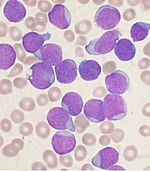
Bone marrow examination is the pathologic analysis of samples of bone marrow obtained via biopsy and os marrow aspiration. Bone marrow exam is used in the diagnosis of a number of conditions, including leukemia, multiple myeloma, anemia, and pancytopenia. The bone marrow produces the cellular elements of the blood, including platelets, scarlet blood cells and white blood cells. While much information tin can be gleaned by testing the blood itself (drawn from a vein by phlebotomy), it is sometimes necessary to examine the source of the blood cells in the bone marrow to obtain more data on hematopoiesis; this is the role of os marrow aspiration and biopsy.[ citation needed ]
The ratio between myeloid series and erythroid cells is relevant to bone marrow function, and also to diseases of the bone marrow and peripheral blood, such as leukemia and anemia. The normal myeloid-to-erythroid ratio is around 3:ane; this ratio may increase in myelogenous leukemias, subtract in polycythemias, and reverse in cases of thalassemia.[24]
Donation and transplantation [edit]
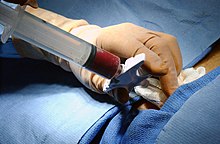
A bone marrow harvest in progress.
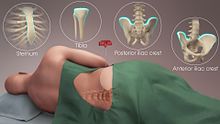
The preferred sites for the procedure
In a os marrow transplant, hematopoietic stem cells are removed from a person and infused into some other person (allogenic) or into the same person at a later time (autologous). If the donor and recipient are uniform, these infused cells will so travel to the bone marrow and initiate blood cell production. Transplantation from 1 person to some other is conducted for the handling of severe bone marrow diseases, such every bit built defects, autoimmune diseases or malignancies. The patient's ain marrow is beginning killed off with drugs or radiation, and then the new stem cells are introduced. Before radiation therapy or chemotherapy in cases of cancer, some of the patient's hematopoietic stem cells are sometimes harvested and subsequently infused dorsum when the therapy is finished to restore the allowed organization.[25]
Bone marrow stem cells can be induced to become neural cells to care for neurological illnesses,[26] and can also potentially be used for the treatment of other illnesses, such equally inflammatory bowel disease.[27] In 2013, following a clinical trial, scientists proposed that bone marrow transplantation could exist used to care for HIV in conjunction with antiretroviral drugs;[28] [29] however, it was subsequently establish that HIV remained in the bodies of the test subjects.[30]
Harvesting [edit]
The stem cells are typically harvested straight from the scarlet marrow in the iliac crest, ofttimes nether full general anesthesia. The procedure is minimally invasive and does not require stitches later on. Depending on the donor'southward health and reaction to the procedure, the actual harvesting tin can be an outpatient procedure, or can crave i–2 days of recovery in the hospital.[31]
Some other choice is to administrate certain drugs that stimulate the release of stem cells from the bone marrow into circulating blood.[32] An intravenous catheter is inserted into the donor's arm, and the stem cells are then filtered out of the blood. This procedure is similar to that used in claret or platelet donation. In adults, bone marrow may as well be taken from the sternum, while the tibia is often used when taking samples from infants.[17] In newborns, stalk cells may be retrieved from the umbilical cord.[33]
Fossil tape [edit]

Bone marrow may take start evolved in Eusthenopteron, a species of prehistoric fish with close links to early on tetrapods.
The earliest fossilised evidence of bone marrow was discovered in 2014 in Eusthenopteron, a lobe-finned fish which lived during the Devonian catamenia approximately 370 million years agone.[34] Scientists from Uppsala University and the European Synchrotron Radiation Facility used X-ray synchrotron microtomography to study the fossilised interior of the skeleton's humerus, finding organised tubular structures alike to mod vertebrate bone marrow.[34] Eusthenopteron is closely related to the early tetrapods, which ultimately evolved into the land-home mammals and lizards of the present day.[34]
See also [edit]
- Myelonecrosis
- National Marrow Donor Program
- Gift of Life Marrow Registry
References [edit]
- ^ Schmidt, Richard F.; Lang, Florian; Heckmann, Manfred (30 November 2010). "What are the organs of the immune system?". Establish for Quality and Efficiency in Wellness Intendance. pp. 3/vii.
- ^ C., Farhi, Diane (2009). Pathology of bone marrow and blood cells (second ed.). Philadelphia: Wolters Kluwer Health/Lippincott William & Wilkins. ISBN9780781770934. OCLC 191807944.
- ^ Arikan, Hüseyin; Çiçek, Kerim (2014). "Haematology of amphibians and reptiles: a review" (PDF). Northward-Western Journal of Zoology. 10: 190–209.
- ^ Katherine, Abel (2013). Official CPC Certification Study Guide. American Medical Association.
- ^ Hindorf, C.; Glatting, M.; Chiesa, C.; Lindén, O.; Flux, G. (2010). "EANM Dosimetry Commission guidelines for os marrow and whole-trunk dosimetry". Eur J Nucl Med Mol Imaging. 37 (6): 1238–1250. doi:10.1007/s00259-010-1422-4. PMID 20411259. S2CID 9755621.
- ^ a b c Birbrair, Alexander; Frenette, Paul Due south. (1 March 2016). "Niche heterogeneity in the bone marrow". Annals of the New York Academy of Sciences. 1370 (1): 82–96. Bibcode:2016NYASA1370...82B. doi:10.1111/nyas.13016. ISSN 1749-6632. PMC4938003. PMID 27015419.
- ^ Lindberg, Matthew R.; Lamps, Laura Due west. (2018). "Bone Marrow". Diagnostic Pathology: Normal Histology. pp. 130–137. doi:10.1016/B978-0-323-54803-eight.50035-eight. ISBN9780323548038.
- ^ a b Chan, Brian Y.; Gill, Kara G.; Rebsamen, Susan 50.; Nguyen, Jie C. (one October 2016). "MR Imaging of Pediatric Bone Marrow". RadioGraphics. 36 (6): 1911–1930. doi:10.1148/rg.2016160056. ISSN 0271-5333. PMID 27726743.
- ^ Poulton, T B; Spud, W D; Duerk, J Fifty; Chapek, C C; Feiglin, D H (1 December 1993). "Bone marrow reconversion in adults who are smokers: MR Imaging findings". American Journal of Roentgenology. 161 (6): 1217–1221. doi:10.2214/ajr.161.6.8249729. ISSN 0361-803X. PMID 8249729.
- ^ Nombela-Arrieta, Cesar; K. Manz, Markus (2017). "Quantification and three-dimensional microanatomical organization of the os marrow". Claret Advances. i (vi): 407–416. doi:10.1182/bloodadvances.2016003194. PMC5738992. PMID 29296956.
- ^ a b c d Raphael Rubin & David S. Strayer (2007). Rubin'southward Pathology: Clinicopathologic Foundations of Medicine. Lippincott Williams & Wilkins. p. xc. ISBN978-0-7817-9516-6.
- ^ Appendix A:Iv in Wintrobe'southward clinical hematology (9th edition). Philadelphia: Lea & Febiger (1993).
- ^ "The Red Prison cell Membrane: construction and pathologies" (PDF). Australian Centre for Blood Diseases/Monash Academy. Retrieved 24 January 2015.
- ^ The Lymphatic System. Allonhealth.com. Retrieved v December 2011.
- ^ Fabricant, Florence. "Begging for Basic: A New Craving for Marrow". The New York Times. September 16, 1998.
- ^ Bonnet, D; Dick, JE (1997). "Man acute myeloid leukemia is organized every bit a hierarchy that originates from a primitive hematopoietic cell". Nature Medicine. iii (7): 730–737. doi:10.1038/nm0797-730. PMID 9212098. S2CID 205381050.
- ^ a b "Os Marrow Aspiration and Biopsy". Lab Tests Online UK. Retrieved sixteen February 2013.
- ^ Mahla RS (2016). "Stem cells application in regenerative medicine and illness threpeutics". International Journal of Cell Biology. 2016 (vii): one–24. doi:10.1155/2016/6940283. PMC4969512. PMID 27516776.
{{cite journal}}: CS1 maint: uses authors parameter (link) - ^ Ellmann, Stephan; Brook, Michael; Kuwert, Torsten; Uder, Michael; Bäuerle, Tobias (2015). "Multimodal imaging of bone metastases: From preclinical to clinical applications". Periodical of Orthopaedic Translation. 3 (4): 166–177. doi:10.1016/j.jot.2015.07.004. PMC5986987. PMID 30035055.
- ^ Nishida, Y; Matsue, Y; Suehara, Y; Fukumoto, K; Fujisawa, M; Takeuchi, M; Ouchi, Eastward; Matsue, M (Baronial 2015). "Clinical and prognostic significance of os marrow abnormalities in the appendicular skeleton detected by low-doe whole-body multidetector computed tomography in patients with multiple myeloma". Claret Cancer Periodical. 5 (vii): e329. doi:10.1038/bcj.2015.57. ISSN 2044-5385. PMC4526783. PMID 26230953.
- ^ Poulton, TB; Murphy, WD; Duerk, JL; Chapek, CC; Feiglin, DH (Dec 1993). "Bone marrow reconversion in adults who are smokers: MR Imaging findings". AJR. American Journal of Roentgenology. 161 (half-dozen): 1217–21. doi:10.2214/ajr.161.6.8249729. PMID 8249729.
- ^ Shah, LM; Hanrahan, CJ (December 2011). "MRI of spinal bone marrow: part I, techniques and normal age-related appearances". AJR. American Periodical of Roentgenology. 197 (6): 1298–308. doi:ten.2214/ajr.11.7005. PMID 22109283.
- ^ Vande Berg, BC; Lecouvet, FE; Galant, C; Maldague, Be; Malghem, J (July 2005). "Normal variants and frequent marrow alterations that simulate bone marrow lesions at MR imaging". Radiologic Clinics of Due north America. 43 (four): 761–70, nine. doi:10.1016/j.rcl.2005.01.007. PMID 15893536.
- ^ "Definition: 'Chiliad:Due east Ratio'". Stedman'southward Medical Lexicon via MediLexicon.com. 2006. Archived from the original on 10 May 2013. Retrieved twenty Dec 2012.
- ^ "Bone marrow transplantation". UpToDate.com. Retrieved 12 April 2014.
- ^ "Antibiotic Transforms Stem Cells Direct Into Brain Cells". Science Daily. 22 April 2013. Retrieved 24 April 2013.
- ^ "Research Supports Promise of Jail cell Therapy for Bowel Disease". Wake Forest Baptist Medical Center. 28 Feb 2013. Retrieved five March 2013.
- ^ "Bone marrow 'frees men of HIV drugs'". BBC. 3 July 2013. Retrieved 3 July 2013.
- ^ "Stem-Cell Transplants Erase HIV In Two Men". PopSci. 3 July 2013. Retrieved 3 July 2013.
- ^ "HIV Returns in Two Men Thought 'Cured' by Os Marrow Transplants". RH Reality Cheque. x Dec 2013. Retrieved 10 Dec 2013.
- ^ National Marrow Donor Program Donor Guide Archived 8 September 2008 at the Wayback Machine. Marrow.org. Retrieved 5 November 2012.
- ^ Os marrow donation: What to expect when you donate. Mayo Clinic. Retrieved 16 February 2013.
- ^ McGuckin, C. P.; Forraz, Due north.; Baradez, Grand. -O.; Navran, S.; Zhao, J.; Urban, R.; Tilton, R.; Denner, L. (2005). "Production of stem cells with embryonic characteristics from human umbilical string blood". Cell Proliferation. 38 (4): 245–255. doi:10.1111/j.1365-2184.2005.00346.10. PMC6496335. PMID 16098183.
- ^ a b c Sanchez, South.; Tafforeau, P.; Ahlberg, P. Eastward. (2014). "The humerus of Eusthenopteron: a puzzling organisation presaging the institution of tetrapod limb bone marrow". Proceedings of the Royal Society B: Biological Sciences. 281 (1782): 20140299. doi:10.1098/rspb.2014.0299. PMC3973280. PMID 24648231.
Farther reading [edit]
- Nature Bone Marrow Transplantation (Nature Publishing Group) – specialist scientific journal with manufactures on bone marrow biology and clinical uses.
- Cooper, B (2011). "The origins of bone marrow as the seedbed of our blood: from artifact to the time of Osler". Baylor Academy Medical Heart Proceedings. 24 (ii): 115–viii. doi:10.1080/08998280.2011.11928697. PMC3069519. PMID 21566758.
- Wang J, Liu X, Lu H, Jiang C, Cui X, Yu L, Fu Ten, Li Q, Wang J (2015). "CXCR4(+)CD45(-) BMMNC subpopulation is superior to unfractionated BMMNCs for protection afterward ischemic stroke in mice". Brain Behav. Immun. 45: 98–108. doi:10.1016/j.bbi.2014.12.015. PMC4342301. PMID 25526817.
External links [edit]
- Bone marrow histology photomicrographs
Source: https://en.wikipedia.org/wiki/Bone_marrow
0 Response to "Why Is Red Marrow Only Found in Babies Why Is Red Marrkw in Babies"
Publicar un comentario